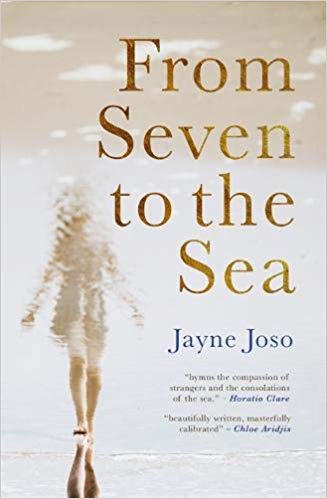Cath Barton casts a critical eye over the fourth novel from Jayne Joso, From Seven to the Sea.
Esther, on her seventh birthday, finds that something else is more important that day for her mother Maud; she is re-marrying. No one has told the girl and she has not met the man who is to be her step-father. Her brief hope that he will be a real father to her is dashed. Although her mum tells her it will be best to call him Dad, Esther refers to him in the story as ‘the man’. No wonder, as although he calls her ‘dear’ he shows her no affection. Indeed, early on we are told that ‘he hated on sight, and would come to detest, Esther, just turned seven.’
 It is a pitiful situation. Esther and Maud move into the man’s house in an unnamed town on a sea coast. There is an island with white sand nearby, and later references to ‘the language of their forefathers’ and slate suggest that this is North Wales. Young Esther has been set adrift, sent to a new school where her teacher is a bully, returning each night to a house which is not a home. Esther likes the artefacts which the man has brought from Africa but he shouts at her for touching them, and her mother seems to be in thrall to this man.
It is a pitiful situation. Esther and Maud move into the man’s house in an unnamed town on a sea coast. There is an island with white sand nearby, and later references to ‘the language of their forefathers’ and slate suggest that this is North Wales. Young Esther has been set adrift, sent to a new school where her teacher is a bully, returning each night to a house which is not a home. Esther likes the artefacts which the man has brought from Africa but he shouts at her for touching them, and her mother seems to be in thrall to this man.
Jayne Joso creates a strong sense of the selfish man and weak woman who mostly leave Esther to her own devices. She seeks refuge in the parallel community of people who moor their boats in the harbour of the town, especially with sailor Pete. Out with him on the water in his fishing boat ‘She was the sea, she was the air’. Esther’s perceptions of nature are synaesthetic – she hears sounds as different colours. It’s a shame that this theme isn’t developed further in the book, in counterpoint to the darkness of Esther’s experience at home and at school.
Joso’s From Seven to the Sea paints a vivid picture of a child adrift and trying to make sense of a world in which she has to find new bearings. It is poignant when, called in by the headmaster who wants to apologise to her, Esther can think only that she must be in trouble. In contrast, she feels on equal terms with Pete and the other boat people. But again here her life-enhancing relationships with those people and with the sea feels underdone, so different from her sad experiences with people who do not seem to want to get to know or understand her, and whose gestures towards that – like giving her a dog – are at best clumsy.
Esther knows nothing of the emotions of adults, and that is completely realistic. When any of us was seven years old, neither parents nor teachers had a life outside the time we were with them. Similarly, we did not look back, and neither does Esther. But we did have rich internal lives, and that is the most interesting thing in a story told primarily from the point of view of a child. Those are the aspects of From Seven to the Sea are most successful. For example, one day her friend Pete is listening to Bach on the radio and introduces Esther to this new experience. As they listen to it together:
… she settled herself to enjoying it too. Bach, and the silence, and the rush sometimes of the wind, a seagull calling, and no reply, and distantly, the sea.
Sailors, she thought, we are sailors. And this is what sailors do.
From Seven to the Sea by Jayne Joso is published by Seren.
You might also like…
Avid Wales Arts Review contributor, Jon Gower casts a critical eye over Horatio Clare‘s Down to the Sea in Ships, a novel inspired by the famous Moby Dick.
Cath Barton won the New Welsh Writing AmeriCymru Prize for the Novella with The Plankton Collector, which is published by New Welsh Review under their Rarebyte imprint. Her second novella will be published by Louise Walters Books in 2020.



 Enjoyed this article? Support our writers directly by buying them a coffee and clicking this link.
Enjoyed this article? Support our writers directly by buying them a coffee and clicking this link.







